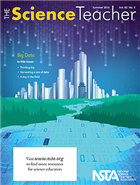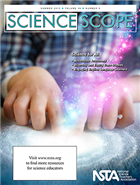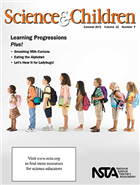NSTA summer journals for K-12 teachers
By Mary Bigelow
Posted on 2015-07-26
 Add these journals to your summer reading!
Add these journals to your summer reading!
The Science Teacher: Big Data
As the editor says this month, “Scientific progress doesn’t result from simply accumulating data.” And data is definitely accumulating rapidly! Analyzing and interpreting data is one of the NGSS science and engineering practices, and how to organize, analyze, and interpret data (from students’ own investigations or from the work of others) and how to recognize valid conclusions from data are important if our students are to be informed citizens and potential scientists. (Career of the Month: Data Analyst).
It’s easy to find articles or news sites that summarize data and present an interpretation, but the editor continues: “…students can engage in the higher-order thinking involved in analyzing and interpreting large science datasets (big data) and designing their own inquiries to discover patterns and meaning in mountains of accessible data.” These data are collected by probes and investigators and are often streamed in real time. The featured articles in this edition focus on classroom strategies for investigations using secondary data.
- Thinking Big: Most students have had experience in data in their own investigations. But students and teachers also have access to large data sets via the Internet, from research projects and citizen science databases. The authors discuss the differences between local and large-scale data sets and how to transition to using “big” data in the classroom. The article has examples of strategies (provided in the Connections), a list of K-12 projects that provide big data, and suggestions for classroom projects.
One of the suggested projects that I am familiar with is NOAA’s Data in the Classroom. Each module has five levels of lessons ranging from teacher-presented ones to letting students explore the data to full-blown problem solving and invention. Each module shows the associated data in a variety of formats and guides the users through how to interpret it. There are “checkup” questions throughout, and teachers can download the materials.
- A Day in the Field introduces the term “secondary data”–data collected by others. Students studied a local estuarine system and shared their data with those collecting similar data at other locations. It was an authentic experience in using analysis tools such as mapping and spreadsheets. As the authors noted “Data analysis is about pattern recognition.”
- Harvesting a Sea of Data describes how students can study migration patterns using data from the Ocean Tracks research program. The project provides opportunities for students to study phenomena in faraway locations. (see also the Oceans of Data website)
[For more on the content that provides a context for these projects and strategies see the SciLinks websites for Birds, Telesccopes, Watersheds, Estuaries, Migration]
Continue for Science Scope and Science and Children.
 Science Scope: Science for All
Science Scope: Science for All
Strategies that help students with learning disabilities, students who are English Language Learners, or students with physical impairments have the added benefit of being appropriate for others. This was also the theme for the April issue of The Science Teacher, so we have a lot of resources on this topic in addition to these featured articles!
- Touching the Stars: Making Astronomy Accessible for Students With Visual Impairments addresses the question of how to help all students with subjects that rely heavily on visual information. The Skynet Junior Scholars online program includes online access to telescopes and data, a student-friendly interface to control telescopes, and instructional modules. The technology also can convert digital images to tactile models. The araticle includes a table of resources for accessible materials.
- The authors of Engineering Progressions in the NGSS Diversity and Equity Case Studies elaborate on the case studies that are part of the NGSS. “While the teaching strategies outlined in the case studies will work well with all students, they were specifically developed to address what classroom teachers can do to ensure that the NGSS is accessible to all students, particulary nondominant student groups.
- Collaborative Concept Maps: A Voice for All Science Learners has examples of how students of different academic levels can make connections and see the relationships between concepts. The authors provide photos of student concept maps created during an activity on adaptation and change over time.
- The Fish Weir: A Culturally Relevant STEM Activity shows how STEM practices can be integrated into lessons for Native American students (as well as others). Specifically, how do people adapt weirs to different environmental condition and migratory patterns. (If your students are not familiar with weirs, the article has several photographs of student-designed ones.
-
If you have students with learning disabilities in your classes, Supporting Science Access for All Students: Using Content Enhancements to Create Pathways to the Big Ideas discusses how to incorporate instructional strategies that make science activities more explicit and connected. This could benefit all students who struggle.
- This month’s Teacher’s Toolkit: “What’s Our Three-Word Claim?”: Supporting
English Language Learning Students’ Engagement in Scientific Argumentation describes three strategies to guide ELL students through a claim-evidence-reasoning lesson, using how antibiotics kill bacteria as the context.
- Tried and True: Fossils, Inquiry, and the English Language Learner concludes with the statement “With proper planning, language does not have to be a limitation to learning science.” The article describes well-planned activities related to an investigation of fossils.
[For more on the content that provides a context for these projects and strategies see the SciLinks websites for Antibiotics, Bacteria, Astronomy, Telescopes, Bird Adaptations, Fishes, Fossil Record, Populations, Communities, and Ecosystems]
 Science and Children: Learning Progressions Plus!
Science and Children: Learning Progressions Plus!
The NGSS provides information to support the development of learning progressions based on research. Students bring different backgrounds and skills to the classroom, so this issue intersects with the Science for All themes of other NSTA K-12 journals.
- Young children playing with clay is a familiar scene in pre-K schools (or it should be). The lesson in The Early Years: A Progression of Learning takes clay to a new level as students explore its properties, as well as learn to create. A similar type of progressing from parts and wholes to conservation of matter is described in Formative Assessment Probes: Snap Block.
- Eating the Alphabet describes an interdisciplinary kindergarten activity involving the sense of taste as students progress through the alphabet with familiar and unfamiliar foods (safety suggestions are provided).
- Dig Into Fossils! is a developmentally appropriate lesson for young children (K-2) in which they get hands-on experiences. For teacher background information, see Science 101: How Do You Date Fossils?
- Who knew that the ubiquitous milk carton could be the focus of an engineerng design project? The activities in Smashing Milk Cartons introduce students to the ideas of recycling and composting and to designing solutions to a school-wide, real-world problem. More engineering applications can be found in Engineering Encounters: You and Your Students as Green Engineers.
- STEM learning does not have to be limited to the classroom. Families Learning Together can be a powerful way to foster a progression of lifelong learning.
- Let’s Hear It for Ladybugs! as student learn about life cycles.
- The two lessons in Teaching Through Trade Books: All the Water in the World illustrate how lessons at the K-2 and 3-5 grade levels can focus on the topic at different levels of sophistication.
[For more on the content that provides a context for these projects and strategies see the SciLinks websites for Watersheds, Water Underground, Fossils, Recycling, Composting, Life Cycles, Metamorphosis, Insects]
Disclaimer: The views expressed in this blog post are those of the author(s) and do not necessarily reflect the official position of the National Science Teaching Association (NSTA).


